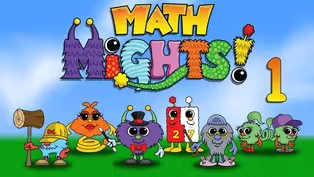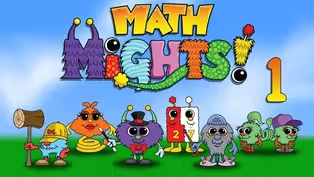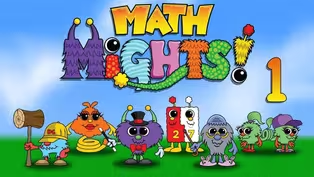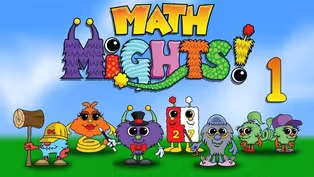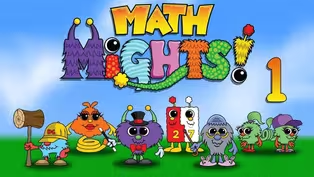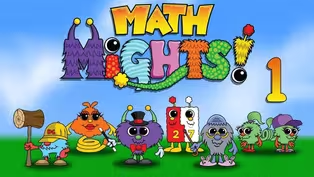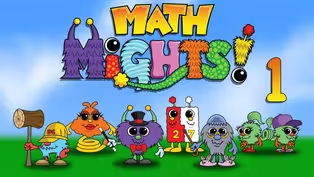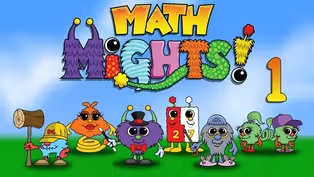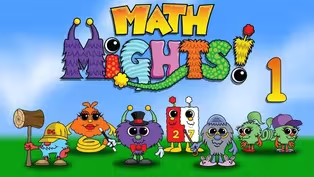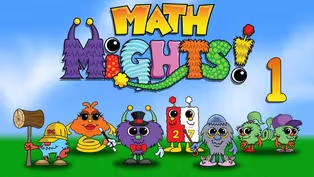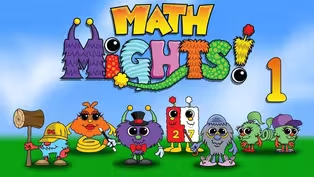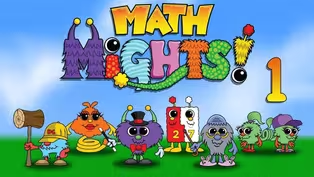Math Mights
Comparing Numbers
Season 2 Episode 217 | 16mVideo has Closed Captions
Join Mrs. Markavich & Dotson for a Numeracy Talk with the Counting Buddy Senior
Join Mrs. Markavich & Dotson for a Numeracy Talk with the Counting Buddy Senior! Let's learn together about "greater than", "less than" and "equal to"!
Problems playing video? | Closed Captioning Feedback
Problems playing video? | Closed Captioning Feedback
Math Mights is a local public television program presented by Detroit PBS
Math Mights
Comparing Numbers
Season 2 Episode 217 | 16mVideo has Closed Captions
Join Mrs. Markavich & Dotson for a Numeracy Talk with the Counting Buddy Senior! Let's learn together about "greater than", "less than" and "equal to"!
Problems playing video? | Closed Captioning Feedback
How to Watch Math Mights
Math Mights is available to stream on pbs.org and the free PBS App, available on iPhone, Apple TV, Android TV, Android smartphones, Amazon Fire TV, Amazon Fire Tablet, Roku, Samsung Smart TV, and Vizio.
Providing Support for PBS.org
Learn Moreabout PBS online sponsorshipMore from This Collection
Video has Closed Captions
Join Mrs. Markavich for a missing addend word problem with Professor Barble! (16m 5s)
Adding Tens-Tens and Ones-Ones
Video has Closed Captions
Join Mrs. Markavich for a missing addend word problem with Professor Barble! (15m 35s)
Write Equations to Match the Strategy
Video has Closed Captions
Join Mrs. Markavich for a missing addend word problem with Professor Barble. (16m 2s)
Video has Closed Captions
Join Mrs. Markavich for a subtraction word problem with Professor Barble. (15m 59s)
Video has Closed Captions
Join Mrs. Markavich for a missing addend word problem. (16m 6s)
Add 2-Digit Numbers & Write Equations
Video has Closed Captions
Join Mrs. Markavich for a word problem with her friend Professor Barble! (15m 59s)
Comparing Numbers Different Ways
Video has Closed Captions
Value Pak shows you the different ways to compare 2-digit numbers. (15m 44s)
Video has Closed Captions
Join Mrs. Markavich for a word problem with her friend Professor Barble! (15m 59s)
Video has Closed Captions
Join Mrs. Markavich for a word problem with her friend Professor Barble! (15m 59s)
Decompose/Compose #'s Different Ways
Video has Closed Captions
We show you different ways to decompose and compose 2-digit numbers! (15m 59s)
Video has Closed Captions
Join Mrs. Markavich & Dotson to talk about numbers with the Counting Buddy Senior! (16m)
Video has Closed Captions
Join Mrs. Markavich for Numeracy Talk with Dotson working on conservation to 20. (16m)
Providing Support for PBS.org
Learn Moreabout PBS online sponsorship(upbeat music) - [Children] Math Mights.
- Hey first grade Math Mights, I'm Mrs Markavich, and I'm so excited that you're here with us today.
Let's check out our plan for the day.
Today, we're going to be doing a Numeracy Talk with our friend Dotson.
And then, we're going to be comparing two digit numbers.
Let's warm up our math brains with our friend Dotson.
Here he comes.
(Dotson thudding) Hey Dotson, welcome.
As we head on over to our famous red carpet, we have a new friend here today with us.
And he is a Counting Buddy Senior.
(shutters clicking) I wanna talk to you a little bit about him before we take that picture.
So let's take a look at my whiteboard and talk about our Counting Buddy Senior.
Here is my new friend, the Counting Buddy Senior.
He has a head up here and he has feet down here and he has all of these beads.
I'm gonna do something that mathematicians do.
I'm going to turn him sideways and this is called linear.
That's a really big word, but you're a mathematician, so I know that that word can stick in your head.
Our Counting Buddy Senior, has two different colors on him.
He has some red beads over here and some blue beads up here.
The red beads are a group of 10 and so are the blue beads.
I can move the beads toward his feet when I am counting.
So I can slide them all the way down to his feet, just like this.
And once I'm done, you'll be able to see two groups of 10.
I have a group of 10 here and I have a group of 10 here.
And if I wanted to add more to my first group of 10, I can slide them down just like this.
So with your great big math brain, you would be able to count 10, 11, 12.
And then I have some beads over here.
I didn't forget about those beads.
Those beads are leftover and they're gonna stay over here, and I could automatically know that if there are 12 on this side, there will be eight leftover on this side.
Now, we're going to take that picture, hold it there, and see if you can figure out how many beads are showing on my Counting Buddy Senior.
Are you ready?
One, two, three.
Take that picture.
Wow, that was really fast friends.
I wonder, did you see a group of 10, like I showed you on our Counting Buddy Senior?
Let's take a look at my three friends, Maggie, Miriam and Terrell and see what they saw.
My friend Maggie saw 14, Miriam saw 15 and Terrell saw 13.
Hmm, they all got a different number.
I wonder if that's possible to have three different numbers.
I think we should maybe check that out.
Let's take a look at my Counting Buddy Senior and what my friends thought.
My first friend saw a group of 10 and 5 more.
Did you get that?
Do you agree with her or do you disagree?
Let's take a look at what she saw on my Counting Buddy Senior.
My friends saw 10, I'm gonna bring those down to his feet, remember.
Four, five, six, seven, eight, nine, 10.
Here is that group of 10.
And then, she said she saw five more.
So that would mean I would need to bring five more down toward the group of ten.
One, two, three, four, five.
So this is what 15 would look like.
A group of 10 and 5 more.
I have another friend and her name is Maggie.
And my friend Maggie says, "I politely disagree with Miriam's answer.
"I think there was 14 and that would look like this, "10 and then 4 more."
This is a little bit different than what our first friends saw.
I wanna take a look back at my original picture to see, because I think Maggie could be right.
And when I look here, I do see 14.
So Maggie is right.
My friend Terrell says, "Wait a minute, wait a minute.
"I wanna change my answer from 13 to 14."
Have you ever done that before?
I know that I have and it's okay to change our answer.
All right, first grade Math Mights.
Let's take a look at our, I can statement of the day.
It's really important that we do this every time we start something new, because we have to have a purpose for what we're doing.
So today, our, I can statements says this.
I can compare a two digit number using a greater than, an equal to, or a less than sign, because I can understand tens and ones.
Now it's time for us, first grade Math Mights, to talk about some of the language that we use in math.
Remember, mathematicians use really big words.
We talked about one of them earlier when we use the word linear.
Now we're going to talk about the words greater than, less than and equal to.
We need to know what those mean in case we don't already.
So, I brought something with me today that you can check out, to help us use the words greater than, less than and equal to.
Let's take a quick look at it.
I brought with me a scale that looks like this.
And on my scale, you can see some apples.
Let's count them together.
One, two, three, on this side, on the left.
And one on this side, on the right.
I can see that there are more on the left, which means there is a greater amount on the left and there are less on the right.
So that means the scale is really tipping this way, because this side is greater than this side.
Now mathematicians, you can use a stem like this, hmm is greater than hmm.
Let's try it with our apples.
Let's try three is greater than one.
Let's say it together, three is greater than one.
Now, let's take a look at it another way.
Let's see what happens when we look at the side that has only one apple.
When we start with one apple, we are saying one is less than three.
And we can put that into a stem.
And I wanna try it with you.
This time our stem would be like this.
Hmm is less than hmm.
Try it with me.
We're going to start with the one and then put the three in.
One is less than three.
One more time friends, one is less than three.
We have one more way that we can do this.
We can make the scale balance or be equal on both sides.
To do that, we need to put some more apple on this side.
So let's add two more apples, one, two.
And when I do that, now our scale is balanced on both sides or equal.
So our math stem this side would say, hmm is equal to hmm.
Try it with me.
Let's try three is equal to three.
Say it with me one more time, three is equal to three.
Let's take a look at what I have here.
What do you notice?
What do you wonder?
Hmm, I see some tens and ones, I wonder what I'm going to do with them.
Let's take a look at my friend, Miriam.
My friend Miriam says that, "The amount on the right "is greater because there are more blocks."
Take a good look at it.
Do you agree or disagree?
I'd like to take a look at it in front of me.
So come on over here and join me.
Let's take a look.
I see some tens and ones.
And I think I know, why Miriam thinks that the amount on the right is greater than the amount on the left.
That's because there are more blocks over here.
I see one, two, three, four, five, six, seven, eight on this side.
And I see one, two, three, four, five, six.
So I see how she sees that.
But you have to remember, that these are tens and these are ones.
So when we're looking at this, we have to remember to count by tens and then count on by ones.
Let's try it.
10, 20, 30, 31, 32, 33.
Ooh, let's try the other group.
Remember, don't start with the ones, we wanna start with the tens.
10, 20, 21, 22, 23, 24, 25, 26.
Hmm, even though this side has more blocks, this part on the left is greater.
And you know what I can do, I can use my friend Value Pak.
Remember him?
Hey Value Pak, come on over, check this out with us.
- [Children] The Value Pak.
I'm going to grab my place value cards to show you what this looks like.
So remember, if I have 10, 20, 30, it looks like this.
And I'm gonna just set that right there for you to see.
That's the number 30.
Then I count the ones, one, two, three.
And there's the three.
Remember, make that three hide the zero to show the number 33.
So I'm just gonna take my three and hide the zero.
Now I'm gonna grab another set of place value strips.
This time, I'm going to count my ones.
One, two, three, four, five, six.
And set that down right there.
Then I'm gonna count the tens, 10, 20, and put it over here.
Remember, this is not 620.
We have to take those ones, the six of them right there and we have to hide that zero to get the number 26.
Don't let that trick you.
Now we have 33 and 26 and I know, that three tens are greater than two tens.
So 33 is greater than 26.
I want you to give that a try.
Say it with me, 33 is greater than 26.
Great job first grade Math Mights, kiss your brain.
All right, friends, you did such a great job with that, that we're gonna use our friend Value Pak to help us out again.
Let's give them a quick call.
Hey, Value Pak, come on back.
We wanna look at these two numbers.
I have the numbers, 64 and 44.
I wanna know which one is greater and how do you know?
And we're going to use the stem, hmm is greater than hmm.
Let's take a look at that.
I have the two numbers, 64 and 44.
Remember, when our friend Value Pak is here, we can pull them apart and really take a good look at those numbers.
So I'm gonna slide these two apart and I have 60 and I have a 4.
On this side when I slide them apart, I have 40 and 4.
I have the same amount of ones in both number.
I have four ones on this side and I have four ones on this side.
Now, I wanna look at the number 40 and the number 60.
I know that 60 is greater than 40.
So when I take my four and hide that zero for both numbers, I know that 64 is greater than 44.
So I want you to say the stem with me, 64 is greater than 44.
Now, we're gonna head on over and take another look using our friend Value Pak, at some more numbers.
This time we have the number 54 and 59.
I wanna think about which one is less.
And how do you know?
So let's take a look at that.
And remember, we're gonna use that stem, hmm is less than hmm.
I put the two numbers in front of me, 54 and 59.
The first thing I'm gonna do, because when I use Value Pak, I can pull those numbers apart as I'm going to pull them apart.
So I have 50 and 4.
And when I slide these ones apart, I have 50 and 9.
What do you see that's the same?
What do you see that's different?
I see that the ones are different.
I have four ones on this side and nine ones on this side but I have a 50 and a 50.
So I know that my tens are the same.
I have to now look at my ones.
And I know that four ones is less than nine ones.
So I know that 54 is less than 59.
I want you to say it with me.
Say 54 is less than 59.
Now it's time for you to try it on your own.
I have a greater than less than game.
You're going to spin and see if your number is greater than, less than or equal to your friend's number.
Have fun trying this.
We had so much fun today.
We had a new friend, the Counting Buddy Senior, join us.
We learn new words, greater than, less than and equal to, and our friend Value Pak joined us for a little while.
Thanks so much friends and I can't wait to see you next time.
Have a fantastic day.
(upbeat music) (happy song) - [Child] Sis4teachers.org.
(tab whooshing) - [Girl] Changing the way you think about math.
- [Woman] This program is made possible with funding from the Michigan Department of Education, Governor's Education Emergency Funds, the state of Michigan and by viewers like you.
(upbeat music)


- Home and How To

Hit the road in a classic car for a tour through Great Britain with two antiques experts.










Careers that Work

Support for PBS provided by:
Math Mights is a local public television program presented by Detroit PBS
